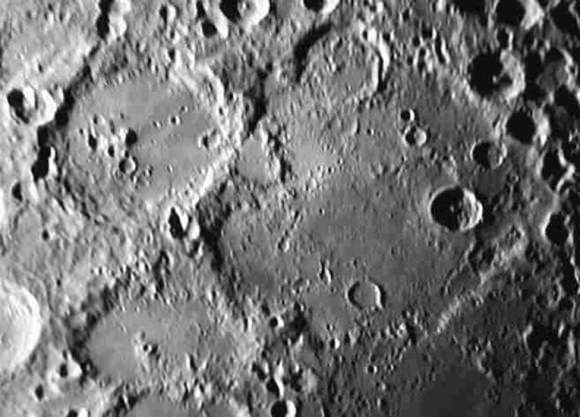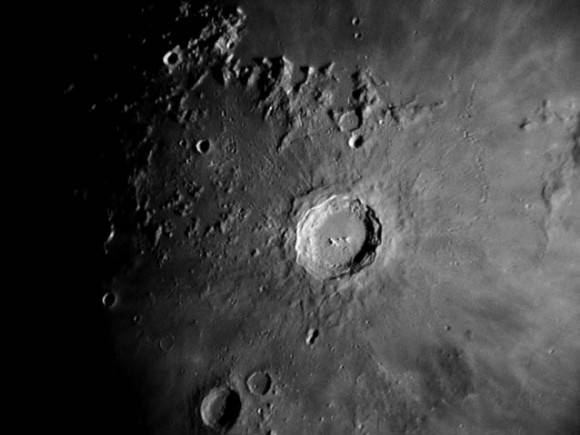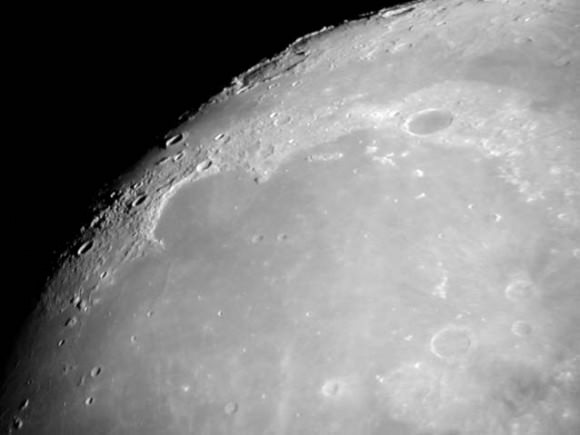Greetings, fellow SkyWatchers! “100 Hours of Astronomy” is now underway – and doesn’t it just figure that most of us are enjoying clouds and rain? Apparently Murphy’s Law (with it’s many variations of names) works everywhere on Earth! But, keep up the good spirits. My own bags are packed and I’m ready to head towards the observatory for the next 3 days of non-stop astronomy programming and here’s some features coming up this weekend I thought you might enjoy sharing as well. Are you ready? Then come on along and let’s have a great time…
Friday, April 3, 2009 – This date marks the 40th anniversary of the launch of the first lunar orbiter, Luna 10. That makes another good reason to view the Moon tonight! Follow the southward descent of large crater rings Ptolemaeus, Alphonsus, and Arzachel to a smaller, bright one southwest named Thebit. We’re going to have a look at Hell.
Just west of Thebit and its prominent Acrater to the northwest, you will see the Rupes Recta (Straight Wall) appearing as a thin, white line. Continue south until you see large, eroded crater Deslandres. On its western shore is a bright ring that marks the boundary of Hell. Although this might seem like an unusual name for a crater, it was named for an astronomer—and clergyman!
While you’re out tonight, be on watch for the Kappa Serpentid meteor shower. Its radiant will be near the ‘‘Northern Crown’’—the constellation known as Corona Borealis. The fall rate is small with an average of 4 or 5 per hour, but this is a great time to just enjoy a Spring evening and share your knowlege with others!
Saturday, April 4, 2009 – Today we celebrate the 1809 birth on this date of astronomer Benjamin Peirce. Peirce was a professor of astronomy and mathematics for nearly 40 years and contributed greatly to the discovery of Neptune.
On the lunar surface, crater Copernicus becomes visible to even the most modest of optical aids. Small binoculars will see Copernicus as a bright ring about mid-way along the lunar dividing line of light and dark called the terminator. Telescopes will reveal its 97-kilometer (60-mile) expanse and 120-meter (395-foot) central peak to perfection. Copernicus holds a special appeal; it’s the aftermath of a huge meteoric impact! At 3,800 meters deep, its walls are 22 kilometers thick. Over the next few days, the impact ray system extending from this tremendous crater will become wonderfully apparent.
Tonight use Copernicus as a guide and look north-northwest to survey the Carpathian Mountains . The Carpathians ring the southern edge of Mare Imbrium, beginning well east of the terminator. But let’s look on the dark side. Extending some 40 kilometers beyond into the Moon’s own shadow, you can continue to see bright peaks, some reaching 2,000 meters high! Tomorrow, when this area is fully revealed, you will see the Carpathians begin to disappear into the lava flow forming them.
Continuing onward to Plato—on the northern shore of Mare Imbrium—and look for the singular peak of Pico. Between Plato and Mons Pico, you will find the many scattered peaks of the Teneriffe Mountains. It is possible that these are the remnants of much taller summits of a once precipitous range. Now the peaks rise less than 2,000 meters above the surface. Time to power up!West of the Teneriffes, and very near the terminator, you will see a narrow line of mountains, very similar in size to the Alpine Valley. Known as the Straight Range, some of its peaks reach as high as 2,000 meters. Although this doesn’t sound particularly impressive, that’s over twice as tall as the Vosges Mountains in west-central Europe and comparable to the Appalachian Mountains of the eastern United States!
 “Sun” Day, April 5, 2009 – Today let’s take a look at Vincenzo Viviani. Born on this date in 1622, Viviani was a mathematician. At age 17, he became the student, secretary, and assistant to Galileo, serving him until the Master died in 1642. Viviani published his own books on mathematical and scientific subjects and edited the first edition of Galileo’s collected works. He was an ardent supporter of Galileo and worked tirelessly to reinstate his mentor’s good name. What a great addition to talk about during the International Year of Astronomy!
“Sun” Day, April 5, 2009 – Today let’s take a look at Vincenzo Viviani. Born on this date in 1622, Viviani was a mathematician. At age 17, he became the student, secretary, and assistant to Galileo, serving him until the Master died in 1642. Viviani published his own books on mathematical and scientific subjects and edited the first edition of Galileo’s collected works. He was an ardent supporter of Galileo and worked tirelessly to reinstate his mentor’s good name. What a great addition to talk about during the International Year of Astronomy!
Tonight let’s continue our lunar mountain-climbing expedition and revisit the ‘‘big picture’’ on the lunar surface. All of Mare Imbrium is bathed in sunlight tonight, and we can see its complete shape. Appearing as a featureless ellipse bordered by mountain ranges, let’s identify them all.
Starting at Plato and moving east to south to west you will find the Alps, the Caucasus, the Apennine, and the Carpathian Mountains. Look at the form closely. Doesn’t it look like it’s possible that an enormous impact created the entire area? Compare it to the younger Sinus Iridum, which is ringed by the Juras Mountains. The latter region may have also been formed by a much later and very similar massive impact event.
Are you in the mood for a double star? Then let’s head west and away from the Moon. Begin your search right after skydark with El Nath. From Beta Aurigae, shift about two finger-widths eastnortheast to identify very dim 26 Aurigae . At low power, look for an 8th magnitude companion due west of the 5.5 magnitude primary. The brighter star should give a warm yellow appearance, while the fainter will appear slightly bluer. This pair shares space with a third member (magnitude 11.5), some three times further out than the closer, brighter secondary. Thanks to lunacy, small instruments will have difficulty distinguishing the C star in such bright skies.
For now? I hope you have clear skies to enjoy the “100 Hours of Astronomy” weekend… and remember to ask for the Moon – but keep on reaching for the stars!
This week’s awesome images – in order of appearance – are credited to these wonderful friends and photographers: Craters Deslandres, Hell and Walter (credit—Alan Chu), Crater Copernicus (credit—Greg Konkel), Vincenzo Viviani (historical image) and Lunar image (credit—Greg Konkel). We thank you so much!




